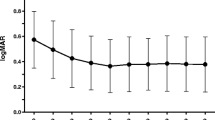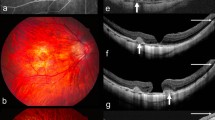Abstract
Background: To assess the natural history of juxtafoveal and subfoveal choroidal neovascularization in eyes with high myopia.Methods: We retrospectively reviewed the charts of 31 patients (31 eyes) with myopia ≥ 6 diopters, well-defined juxtafoveal (1–200 μm from the foveal center) or subfoveal choroidal neovascularization (CNV) on fluorescein angiography at baseline, no prior laser treatment, age ≤ 55 years and presenting visual acuity (VA) ≥ 20/200. Initial and final VA were compared with the Wilcoxon signed rank test. Multifactor analysis of variance was used to assess the association between baseline characteristics of the lesion and final VA. Results: Twenty-two patients were females and 9 males with a median age of 44 years (range 14–55). Median diopters spherical equivalent was -11.5 (range -6, -25). Follow-up ranged from 1 to 20 years (median, 3 years). Nine eyes had juxtafoveal CNV and 22 subfoveal involvement. Median final VA (20/100) was significantly worse than median initial VA (20/50)(p = 0.02). A decrease in VA ≥ 2 lines occurred in 18 eyes, whereas 8 eyes remained stable and 5 improved (4 juxtafoveal membranes and 1 subfoveal membrane). Of the 9 juxtafoveal CNV, 7 had a final VA ≥ 20/40 after a median follow-up of 4 years. By contrast, only 2 of the 22 subfoveal CNV had a final VA ≥ 20/40 (median, 20/100) with a median follow-up of 2.5 years. The only factor associated with better final VA was the initial location of CNV (p = 0.0000). Conclusion: This study confirms the poor functional outcome of subfoveal CNV in degenerative myopia with more than 70% of patients having a final VA of 20/100 or less. Juxtafoveal CNV shows a better functional prognosis. These differences should be considered when planning treatment strategies.
Similar content being viewed by others
References
Cohen S, Laroche A, Leguen Y, Soubrane G, Coscas G. Etiology of choroidal neovascularization in young patients. Ophthalmol 1996; 103: 1241–1244.
Curtin BJ, Karlin DB. Axial length measurements and fundus changes in the myopic eye. Am J Ophthalmol 1971; 71: 42–53.
Grossniklaus HE, Green WR. Pathologic findings in pathologic myopia. Retina 1992; 12: 127–133.
Hotchkiss ML, Fine SL. Pathological myopia and choroidal neovascularization. Am J Ophthalmol 1981; 91: 177–183.
Levy JH, Pollock HM, Curtin BJ. The Fuchs' spot: An ophthalmoscopic and fluorescein angiographic study. Ann Ophthalmol 1977; 9: 1433–1443.
Hampton GR, Kohen D, Bird AC. Visual prognosis of disciform degeneration in myopia. Ophthalmology 1983; 90: 923–926.
Soubrane G, Pison J, Bornert P, Perrenoud F, Coscas G. Neovaisseaux sous-rétiniens de la myopie dégénerative: Résultats de la photocoagulation. Bull Soc Ophtalmol Fr 1986; 86: 269–272.
Turut P, Hochart G, Isorni MC, Houin P. L'évolution spontanée à long terme des neovaisseaux sous-rétiniens des myope. A propos de 61 cas. Bull Soc Ophtalmol Fr 1987; 2: 275–277.
Avila MP, Weiter J, Jalkh A, Trempe CL, Pruett RC, Schepens CL. Natural history of choroidal neovascularization in degenerative myopia. Ophthalmology 1984; 91: 1573–1581.
Fried M, Siebert A, Meyer-Schwickerath G, Wessing A. Natural history of Fuchs' spot: A long term follow-up study. Doc Ophthalmol Proc Ser 1981; 28: 215–221.
Secretan M, Kuhn D, Soubrane G, Coscas G. Long-term visual outcome of choroidal neovascularization in pathologic myopia: Natural history and laser treatment. Eur J Ophthalmol 1997; 7: 307–316.
Tabandeh H, Flynn H, Scott I et al. Visual acuity outcomes of patients 50 years of age and older with high myopia and untreated choroidal neovascularization. Ophthalmology 1999; 106: 2063–2067.
Yoshida T, Ohno-Matsui K, Ohtake Y. Long term visual prognosis of choroidal neovascularization in high myopia. Ophthalmol 2002; 109: 712–719.
Verteporfin in Photodynamic Therapy (VIP report No. 1). Photodynamic therapy of subfoveal choroidal neovascularization in pathologic myopia with verteporfin. Ophthalmol 2001; 108: 841–852.
Bottoni F, Perego E, Airaghi P et al. Surgical removal of subfoveal choroidal neovascular membranes in high myopia. Graefe's Arch Clin Exp Ophthalmol 1999; 237: 573–582.
Piermarocchi S, Pilotto E, Segato T. High myopia and choroidal neovascularization: Microperimetry guided selection for photocoagulation. Invest Ophthalmol Vis Sci 1998; 39(4 suppl): S389.
Author information
Authors and Affiliations
Rights and permissions
About this article
Cite this article
Bottoni, F., Tilanus, M. The Natural History of Juxtafoveal and Subfoveal Choroidal Neovascularization in High Myopia. Int Ophthalmol 24, 249–255 (2001). https://doi.org/10.1023/A:1025488429802
Issue Date:
DOI: https://doi.org/10.1023/A:1025488429802




